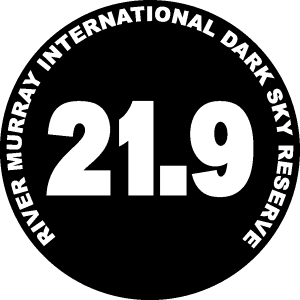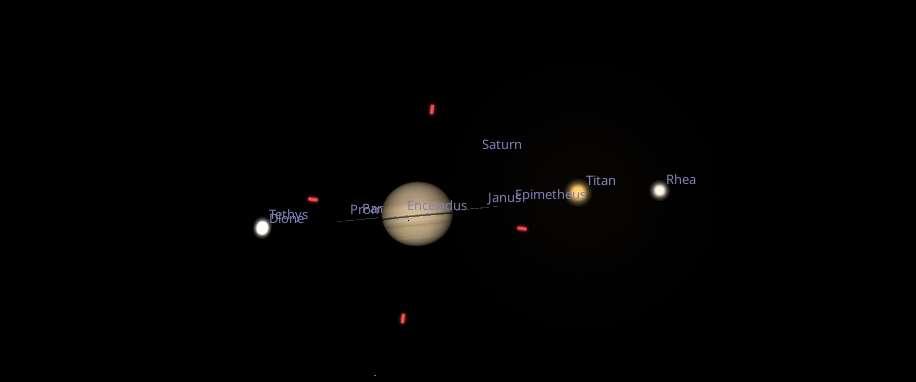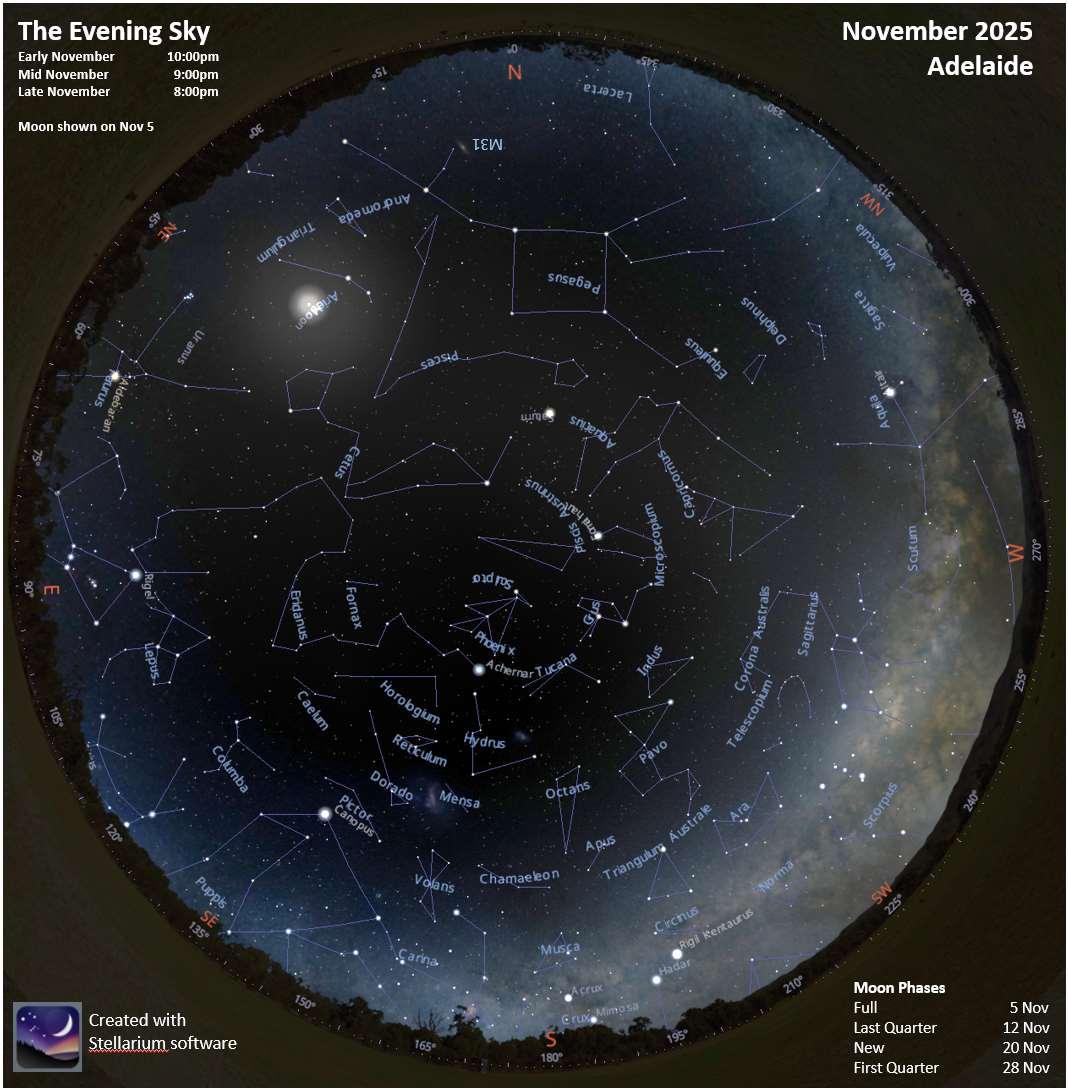
A guide to what's up in the sky for Southern Australia
Starwatch for November 2025 - Wed 29th Oct 2025
Published 29th Oct 2025
A 101 years ago, on November 23, 1924, the universe got larger.
Starwatch for October 2025 - Thu 2nd Oct 2025
Published 2nd Oct 2025
Astronomical distances can be mind boggling. Our closest neighbour, the Moon, is 380,000 kms away — equal to about 10 trips around Earth’s equator.
Starwatch for September 2025 - Wed 3rd Sep 2025
Published 3rd Sep 2025
A few lingering stars of winter are still in view during the evening. Antares, Altair, Vega have lit up the cold winter nights for us. But there is really only one bright star that puts in its best showing during these early spring nights:
NGC 7293 – The Helix Nebula - Tue 2nd Sep 2025
Published 2nd Sep 2025
Image © Patrick Cosgrove. The Helix Nebula, also known as NGC 7293, is a planetary nebula (PN) located in the constellation Aquarius.
Starwatch for August 2025 - Sun 3rd Aug 2025
Published 3rd Aug 2025
Imagine yourself sitting on a rock on the dark side of Moon, gazing up at the Milky Way. There's no stray lights, no atmosphere to dull your view of the night sky. The stars are so brilliant, so big, you could reach out and touch them.
NGC 4755 - Fri 1st Aug 2025
Published 1st Aug 2025
The Jewel Box Star Cluster. Image © Sergio Equivar, Buenos Aires, Argentina
Starwatch for July 2025 - Thu 3rd Jul 2025
Published 3rd Jul 2025
Look up overhead on any of these frosty winter’s nights, and if you have a dark area away from direct lighting, you’ll see the Milky Way shining brightly.
Galaxy NGC 6744 in Pavo - Wed 2nd Jul 2025
Published 2nd Jul 2025
This is NGC 6744, a spiral galaxy bearing similarities to our home galaxy, the Milky Way.
Starwatch for June 2025 - Mon 2nd Jun 2025
Published 2nd Jun 2025
The winter Milky Way shines across the sky from east to west in a blaze of starlight.
Eta Carinae Nebula (NGC 3372) - Sun 1st Jun 2025
Published 1st Jun 2025
Eta Carinae Nebula (NGC 3372) Distance: 7500 Light Years
Starwatch for May 2025 - Wed 30th Apr 2025
Published 30th Apr 2025
We have recently seen the destructive power of extreme weather events, such as cyclones and the flooding in southwest Queensland. It left in its wake flooded businesses, broken roads, power outages, and other problems. The repair bill will run into billions of dollars.
NGC 5139 - Omega Centauri - Tue 29th Apr 2025
Published 29th Apr 2025
Globular Cluster in Centaurus
Starwatch for April 2025 - Wed 2nd Apr 2025
Published 2nd Apr 2025
The crisp autumn evenings of April offer an ideal opportunity to explore the majesty of the southern sky. Go find yourself a nice dark spot in the back-garden, and let your eyes become accustomed to the darkness. Notice how many more stars you can see, even after a few minutes, as the pupils of your eyes expand to let as much light in as possible.
IC434 -The Horsehead Nebula - Tue 1st Apr 2025
Published 1st Apr 2025
Distance: 1500 Light Years |Constellation - Orion
Starwatch - March 2025 - Mon 3rd Mar 2025
Published 3rd Mar 2025
There's nothing more magical than to lie down on your back lawn on a warm summer evening and gaze up at the brilliant night sky.
Eta Carinae Nebula (NGC 3372) - Sat 1st Mar 2025
Published 1st Mar 2025
Distance: 7500 Light Years
Starwatch - February 2025 - Wed 5th Feb 2025
Published 5th Feb 2025
Two bright beacons hold centre stage in our night sky during February. In the beautiful pastel hues of an Australian summer sunset.
M104 - The Sombrero Galaxy - Tue 4th Feb 2025
Published 4th Feb 2025
Distance: 31 Million Light Years
Starwatch - January 2025 - Wed 1st Jan 2025
Published 1st Jan 2025
There's nothing more magical than to lie down on your back lawn on a warm summer evening and gaze up at the brilliant night sky.
The Pleiades star cluster - Tue 31st Dec 2024
Published 31st Dec 2024
The Pleiades star cluster (The Seven Sisters) Distance: 435 Light Years
Starwatch - December 2024 - Sun 1st Dec 2024
Published 1st Dec 2024
The stars that shine at night do so from immense distances.
Starwatch - November 2024 - Mon 4th Nov 2024
Published 4th Nov 2024
We recently saw the destructive power of hurricanes Milton and Helene, as they cut a path of destruction through various states in the US. They left in their wake flooded businesses, broken roads, power outages, and other problems. The repair bill will run into billions of dollars.
Large Magellanic Cloud - Fri 1st Nov 2024
Published 1st Nov 2024
Distance: 163,000 light years Right Ascension 05 : 23.6 Declination -69 : 45
Starwatch - October 2024 - Mon 30th Sep 2024
Published 30th Sep 2024
After a spectacular encounter with Pluto back in July 2015, the New Horizons spacecraft was redirected to visit a more distant object, known as 2014 MU69.
OCTOBER’S DEEP SKY HIGHLIGHT - Sun 29th Sep 2024
Published 29th Sep 2024
M31—The Andromeda Galaxy Distance: 2.5 million Light Years
Starwatch - September 2024 - Sat 31st Aug 2024
Published 31st Aug 2024
Spring is just around the corner, and with it, comes the promise of warmer evenings and clearer skies. And hopefully the opportunity to spend more time looking up!
NGC 253 – Galaxy in Sculptor - Fri 30th Aug 2024
Published 30th Aug 2024
NGC 253 is the brightest member of the Sculptor Group of galaxies.
Starwatch - August 2024 - Tue 30th Jul 2024
Published 30th Jul 2024
f you're brave enough to venture outside these cold winter nights, you'll be greeted by the heart of our Milky Way galaxy directly overhead. Find yourself a dark space in your backyard on a clear moonless night, and look straight up.
The Swan Nebula - Mon 29th Jul 2024
Published 29th Jul 2024
M17 – The Swan Nebula in Sagittarius
Starwatch July 2024 - Mon 8th Jul 2024
Published 8th Jul 2024
Look up overhead on any of these frosty winter’s nights, and as long as you have a dark area away from direct lighting, you’ll see the band of the Milky Way shining brightly.
Merging Galaxies - Sun 7th Jul 2024
Published 7th Jul 2024
NGC 4038-4039 Merging Galaxies - The Antennae. Distance: 45 million Light Years.
Starwatch June 2024 - Sun 2nd Jun 2024
Published 2nd Jun 2024
About half-way up the northern evening sky, a bright star shines.
The Trifid Nebula - Sat 1st Jun 2024
Published 1st Jun 2024
M20 – The Trifid Nebula in Sagittarius
Starwatch May 2024 - Thu 2nd May 2024
Published 2nd May 2024
A myriad of bright stars adorn the late autumn evening sky.
Galaxy NGC 5128 - Wed 1st May 2024
Published 1st May 2024
Galaxy NGC 5128—Centaurus A
Comet Pons-Brooks - Wed 10th Apr 2024
Published 10th Apr 2024
Looking west on the evening of April 27., 30 minutes after sunset. Locate the orange star Aldebaran, then scan to the left until you come to a fuzzy spot in the sky. Train your binoculars on it, the comet will be 239 million kilometres away. Graphic generated with Stellarium planetarium software.
M104 - The Sombrero Galaxy - Tue 9th Apr 2024
Published 9th Apr 2024
M104 - The Sombrero Galaxy. Distance: 31 Million Light Years
Starwatch - April 2024 - Mon 8th Apr 2024
Published 9th Apr 2024
Some of the brightest stars in the whole sky can be seen during these crisp autumn evenings.
Starwatch - March 2024 - Wed 6th Mar 2024
Published 6th Mar 2024
What a wonderful time of the year this is to be observing the night sky. The weather is warm, the nights clear, and the Milky Way shines directly overhead!
Object of the Month - Mon 4th Mar 2024
Published 4th Mar 2024
Eta Carinae Nebula (NGC 3372)
Distance: 7500 Light Years
Right Ascension: 10 : 43.8 | Declination: -59 : 52
A 101 years ago, on November 23, 1924, the universe got larger.
A 101 years ago, on November 23, 1924, the universe got larger. Not in a physical sense, but we came to understand how big it really was. The New York Times reported that astronomer, Edwin Hubble, had made a big discovery. He confirmed that many of the spiral objects known as nebulae were really separate galaxies, “island universes” of stars far outside the Milky Way. It was the first public announcement of one of the greatest scientific findings of the 20th century. The discovery dramatically expanded the known universe. Instead of consisting of the Milky Way alone, the universe contained billions of galaxies, spread across billions of light-years of space.
Hubble studied a class of stars in two spiral nebulae – Andromeda and M33. Called Cepheid variables, the stars pulse in and out. Measuring the length of its pulses and other details reveals the star’s true brightness. From that, astronomers can calculate the star’s distance.
Hubble calculated that Andromeda was about 860,000 light-years away, and M33 a bit farther. Modern calculations show that they are about three times farther than Hubble thought. Still, the concept was proved: the universe extends far beyond our galactic home.
Andromeda, now known as the Andromeda Galaxy (M31) is low in the north at nightfall. See the star chart for location. Under dark skies, it is visible to the eye alone, a whopping 2.5 million light-years away. Binoculars will provide a very pleasing view.
A lone blue-white star shines brightly in the early evening south-eastern sky during November. The star is Canopus, the second brightest star in the whole sky. I have always regarded the first sighting of this brilliant star low in the south-eastern sky as a sure indication that the warmer evenings of summer are on their way.
Canopus is quite different from the Sun. It's a supergiant; many times bigger and heavier than the Sun. It is also more than 10,000 times brighter than the Sun, so is easily visible across more than 300 light-years of space. It is nearing the end of its life, and within the next few million years should explode as a supernova. When that happens, Canopus will briefly outshine everything else in the sky except the Sun.
Low in the north-eastern sky, the Pleiades, or more commonly known as the Seven Sisters, can be seen glowing like a small bright cloud in the constellation of Taurus, the bull. Examine them with your binoculars, and they'll transform into a myriad of jewels against the black of the night. The Pleiades is really a cluster of several hundred stars about 425 light-years from Earth. The stars were born about a hundred million years ago from a single large cloud of gas and dust, which makes them all sisters. That seems appropriate, since the Pleiades are the daughters of Atlas in ancient Greek legend.
Currently visiting Taurus is one of the outer planets of our solar system. The planet Uranus is 20 times farther from the Sun than Earth is. It is very cold in the outer solar system. As a result, its 28 known moons all shiver at hundreds of degrees below zero. Yet several of the planet’s bigger moons might have active volcanoes. Instead of molten rock, they belch out molten ice, a slushy brew from buried oceans of liquid water.
We don’t know for sure if any of the moons have ice volcanoes, but there’s evidence that they do. The surfaces of the moons are fairly young, for example. That suggests that something is renewing them – like material from the interior. And a couple of the moons appear to be pumping material into the space around Uranus.
Recent observations by Webb Space Telescope found additional evidence for an ocean on the moon Ariel. It’s coated with frozen carbon dioxide. Webb found the layer of CO2 is especially thick. And it’s mixed with carbon monoxide. Both compounds should quickly vaporize and drift off into space. Their presence suggests the supply is being renewed, perhaps by volcanoes belching ice from a hidden ocean.
There are now over 6000 confirmed exoplanets (planets around other stars), and half of those are about the same size and mass as Uranus and Neptune, two of the giants of our own solar system. But we don’t know much about these exoplanets, in part because we don’t know much about Uranus and Neptune themselves. They’re billions of kilometres away, and only one mission has visited either planet. There is talk of another space mission to Uranus in the future, so it’ll be a while before we get a close look at this common type of giant planet.
Uranus is an oddball. It lies on its side, probably the result of a collision with another planet when it was young. The sideways orientation also gives Uranus a cycle of seasons unlike that of any other planet.
Right now, Uranus is low in the east in the early evening. You can find it just a few degrees to the right and above the Pleiades. You will need binoculars to locate it. The blue-green of its disc makes it unmistakeable.
Another planet also adorns the evening sky. This one is a lot easier to find. Located high in the northern sky between the constellations of Pisces and Cetus, Saturn is not the spectacular sight we have been used to. Its glorious set of rings are seen edge-on and are practically invisible to us. Because Saturn’s axis of rotation is tilted at about 27o , the orientation of its rings changes as it orbits the Sun. Saturn takes just over 29 years to orbit the Sun and our viewing angle shits. Every 14 years or so, Earth passes directly through the plane of Saturn’s rings. During this time, we see the rings edge-on, making them appear as a thin line, or even vanish, because they’re incredibly thin (less than 50 metres thick). The tilt will get larger over the next year, returning Saturn and its rings to the view we are accustomed to.
Fun fact – the rings are over 200,000 kilometres wide, but if we scaled them down to the distance between Perth and Sydney, they would be the thickness of a piece of paper.
The Moon is Full on November 5, at Last Quarter on November 12, New on November 20 and at First Quarter on November 28.
Happy observing!

